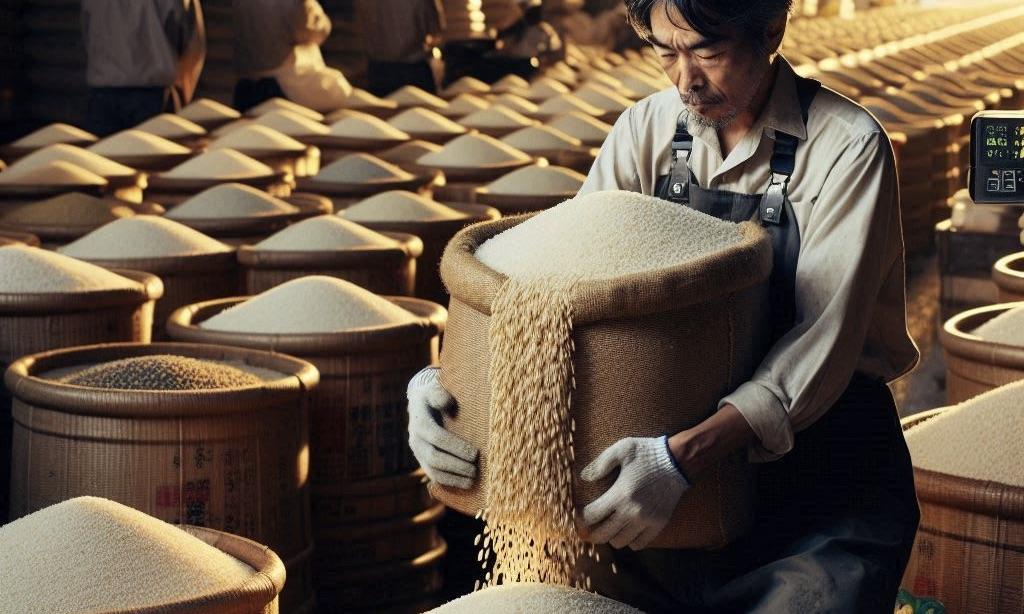Japan's private sector rice inventory fell to a record low of 1.56 million tons in June, the lowest since 1999. The drop, driven by last year's heat and increased tourism, has raised concerns about rising prices amid ongoing high demand.
Japan's Rice Inventory Drops to Record Low Due to Heat and Tourism, Prices Expected to Rise
The farm ministry announced on July 30 (via Japan Today) that Japan's private sector rice inventory decreased to 1.56 million tons in June, the lowest level since comparable data was first recorded in 1999. This represents a 20% decrease from the previous year. The crop was impacted by last year's summer heat and the increased demand for rice fueled by inbound tourism.
There are concerns that the inventory may continue to decrease, resulting in price increases due to the high temperatures that have persisted this summer.
Although the annual demand for rice in Japan had been decreasing due to the country's declining population, preliminary data indicated that the domestic market for the year through June was 7.02 million tons, an increase of 110,000 tons from the previous year. This marks the first increase in ten years.
According to the ministry, one factor that contributed to the increase in demand was the common perception that the rise in rice prices was relatively reasonable compared to those of bread or noodles.
Tourism Boost and Weak Yen Drive Up Japan's Rice Prices to 11-Year High, Yet Market Remains Stable
According to a 2023 report on foreign visitors to Japan by the Japan Tourism Agency, eliminating COVID-19 travel restrictions and a weak yen have increased the number of tourists visiting Japan, with the consumption of Japanese cuisine being a top priority.
In June, the average price of rice produced in 2023 reached 15,865 yen per 60 kilograms when producer cooperatives sold it to wholesalers, the highest level in approximately 11 years.
Despite the challenges, the ministry reassures that the supply-demand balance is not in a crisis. The distribution of rice produced in 2024 is still underway, indicating the market's resilience.
The government's projection for the future is optimistic. It anticipates a decrease in domestic demand to 6.73 million tons during the same month and a decrease in rice inventory to 1.52 million tons by June of the following year, paving the way for potential growth in the market.



 Citi Forecasts a Volatile but Ongoing Bull Market for S&P 500 in 2026
Citi Forecasts a Volatile but Ongoing Bull Market for S&P 500 in 2026  Oil Prices Stabilize at Start of 2026 as OPEC+ Policy and Geopolitical Risks Shape Market Outlook
Oil Prices Stabilize at Start of 2026 as OPEC+ Policy and Geopolitical Risks Shape Market Outlook  Trump Delays Tariff Increases on Furniture and Cabinets for One More Year
Trump Delays Tariff Increases on Furniture and Cabinets for One More Year  U.S. Dollar Slides Toward Biggest Annual Loss Since 2017 as 2026 Risks Loom
U.S. Dollar Slides Toward Biggest Annual Loss Since 2017 as 2026 Risks Loom  South Korea Factory Output Misses Forecasts in November Amid Ongoing Economic Uncertainty
South Korea Factory Output Misses Forecasts in November Amid Ongoing Economic Uncertainty  Singapore GDP Growth Surges in 2025 but Outlook Remains Cautious Amid Global Trade Risks
Singapore GDP Growth Surges in 2025 but Outlook Remains Cautious Amid Global Trade Risks  Wall Street Ends Mixed as Tech and Financial Stocks Weigh on Markets Amid Thin Holiday Trading
Wall Street Ends Mixed as Tech and Financial Stocks Weigh on Markets Amid Thin Holiday Trading  China Manufacturing PMI Rebounds in December, Offering Boost to Economic Growth Outlook
China Manufacturing PMI Rebounds in December, Offering Boost to Economic Growth Outlook  U.S. Stock Index Futures Steady as Markets Await Fed Policy Clues in Holiday-Thinned Trade
U.S. Stock Index Futures Steady as Markets Await Fed Policy Clues in Holiday-Thinned Trade  South Korea Inflation Rises to 2.3% in December, Matching Market Expectations
South Korea Inflation Rises to 2.3% in December, Matching Market Expectations  China Imposes 55% Tariff on Beef Imports Above Quota to Protect Domestic Industry
China Imposes 55% Tariff on Beef Imports Above Quota to Protect Domestic Industry  Asia Manufacturing PMI Rebounds as Exports and Tech Demand Drive Growth into 2026
Asia Manufacturing PMI Rebounds as Exports and Tech Demand Drive Growth into 2026  USDA $12 Billion Farm Aid Program Draws Mixed Reactions from Row Crop Farmers
USDA $12 Billion Farm Aid Program Draws Mixed Reactions from Row Crop Farmers  Federal Reserve Begins Treasury Bill Purchases to Stabilize Reserves and Money Markets
Federal Reserve Begins Treasury Bill Purchases to Stabilize Reserves and Money Markets  Oil Prices Slide in 2025 as Oversupply and Geopolitical Risks Shape Market Outlook
Oil Prices Slide in 2025 as Oversupply and Geopolitical Risks Shape Market Outlook  Oil Prices Slip Slightly as Markets Weigh Geopolitical Risks and Supply Glut Concerns
Oil Prices Slip Slightly as Markets Weigh Geopolitical Risks and Supply Glut Concerns  South Korea Factory Activity Returns to Growth in December on Export Rebound
South Korea Factory Activity Returns to Growth in December on Export Rebound 































